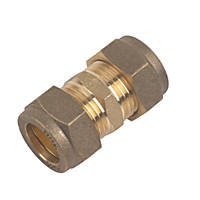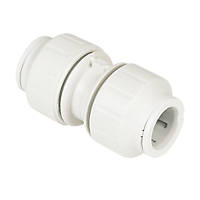We’d like to remind Forumites to please avoid political debate on the Forum.
This is to keep it a safe and useful space for MoneySaving discussions. Threads that are – or become – political in nature may be removed in line with the Forum’s rules. Thank you for your understanding.
📨 Have you signed up to the Forum's new Email Digest yet? Get a selection of trending threads sent straight to your inbox daily, weekly or monthly!
Insulating Push-Fit Fittings — How?
paperclap
Posts: 779 Forumite




Hi all,
I am planning to run 15mm copper pipe in my loft (flow and return pipes for central heating). Had thought about connecting runs of pipe with plastic push-fit fittings.
But, as they’re really bulky, how can they be insulated? The typical foam insulation that I’ll be using for the 15mm pipe can’t be used.
I am planning to run 15mm copper pipe in my loft (flow and return pipes for central heating). Had thought about connecting runs of pipe with plastic push-fit fittings.
But, as they’re really bulky, how can they be insulated? The typical foam insulation that I’ll be using for the 15mm pipe can’t be used.
Thanks!
0
Comments
-
You can get pipe insulation for bigger pipes. But if you use solder fittings, it will be a) cheaper, and b) allow you to use 15mm insulation.
Any language construct that forces such insanity in this case should be abandoned without regrets. –
Erik Aronesty, 2014
Treasure the moments that you have. Savour them for as long as you can for they will never come back again.1 -
This seller on eBay sells a range of the larger sizes of Armaflex insulation: PipeLagging | eBay Stores
Sell the excess on eBay or keep for your next project.The comments I post are my personal opinion. While I try to check everything is correct before posting, I can and do make mistakes, so always try to check official information sources before relying on my posts.1 -
Or compression fittings. Why did you suddenly decide to use push-fit?laurencewhymark said:
Think I may just use solder fittings! Keep things simpleFreeBear said:You can get pipe insulation for bigger pipes. But if you use solder fittings, it will be a) cheaper, and b) allow you to use 15mm insulation.
1 -
why not use plastic pipe in the loft? if you buy a coil of the lay flat pipe, you shouldn't need any joins.0
-
Pushfit are a good systelm. I generally use Tectite pushfit fittings when doing plumbing. The Tectite Pro fittings maintain electrical continuity through them if this is required.The comments I post are my personal opinion. While I try to check everything is correct before posting, I can and do make mistakes, so always try to check official information sources before relying on my posts.0
-
laurencewhymark said:
Think I may just use solder fittings! Keep things simpleFreeBear said:You can get pipe insulation for bigger pipes. But if you use solder fittings, it will be a) cheaper, and b) allow you to use 15mm insulation.
I just use some 22mm insulation, cut a piece the same length as the fitting, open one long side and slip it over the fitting. It won't fit snugly and there will be a bit of a gap, so I fill that with a segment of another piece of 22mm insulation. Then wrap with duct tape to keep it all together.
'T's can be done the same way, but carefully carving some of the foam away to fit round the side connection.
If you decide to solder in the loft then be extra careful of the fire hazards, and the difficulty of getting out of the loft yourself if anything goes wrong. Also consider the harmful effect of fumes created when flux is being burnt off. Make sure you have plenty of ventilation. And after making a joint, consider going out of the loft into the fresh air for a while to let the fumes disperse.
0 -
I hadn’t really considered compression fittings, as they’re more expensive than push-fit. But, suppose I could!grumbler said:
Or compression fittings. Why did you suddenly decide to use push-fit?laurencewhymark said:
Think I may just use solder fittings! Keep things simpleFreeBear said:You can get pipe insulation for bigger pipes. But if you use solder fittings, it will be a) cheaper, and b) allow you to use 15mm insulation.0 -
laurencewhymark said:
I hadn’t really considered compression fittings, as they’re more expensive than push-fit.grumbler said:
Or compression fittings. Why did you suddenly decide to use push-fit?laurencewhymark said:
Think I may just use solder fittings! Keep things simpleFreeBear said:You can get pipe insulation for bigger pipes. But if you use solder fittings, it will be a) cheaper, and b) allow you to use 15mm insulation.I don't think so
0 -
I wouldn't. Only on fittings (e.g. valves) where a compression connector is the norm, and push-fit alternatives are rather costly.laurencewhymark said:I hadn’t really considered compression fittings, as they’re more expensive than push-fit. But, suppose I could!
Compression fittings have the same bulkiness issue as pushfit, you won't be much further forward. You are right that they cost more, but they are also more time consuming to make, and are demountable but require more effort to clean up and prepare to remount/reuse.
One option to consider is whether you can make up sections of pipework with soldered joints outside, then fit them together in the loft using a minimal number of push fit joints. One advantage of that approach is after soldering you can flush the assembled pipes using a hose outside to reduce the amount of flux and debris that will need removing when the system is commissioned.
Obviously you'll be limited in the size of the pipe assembly by what you can get through the loft hatch. Although, for example, if you make up an 'L' shaped run consisting of the vertical drop plus the horizontal link to the main flow/return pipe then you may be able to feed the horizontal section up into the loft via the hole in the ceiling that you needed to make for the drop. In that way you could avoid having to make a joint in the confined space of the eaves.
0
Confirm your email address to Create Threads and Reply

Categories
- All Categories
- 352.9K Banking & Borrowing
- 253.9K Reduce Debt & Boost Income
- 454.7K Spending & Discounts
- 246K Work, Benefits & Business
- 602K Mortgages, Homes & Bills
- 177.8K Life & Family
- 259.9K Travel & Transport
- 1.5M Hobbies & Leisure
- 16K Discuss & Feedback
- 37.7K Read-Only Boards





